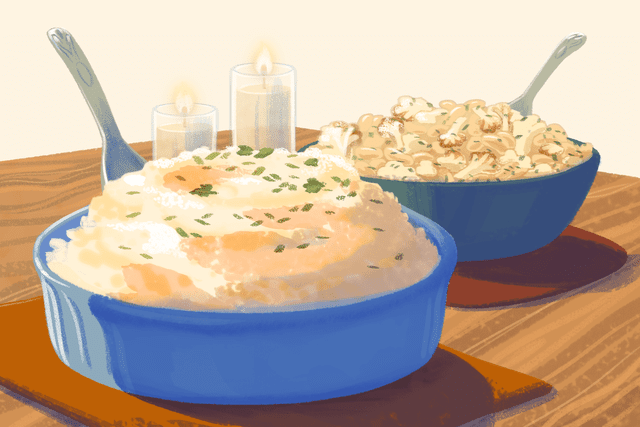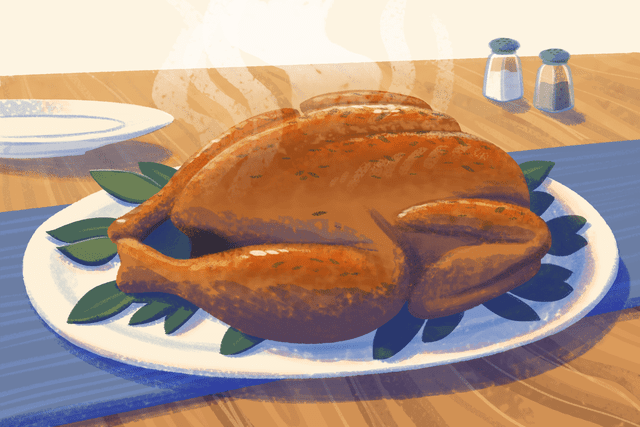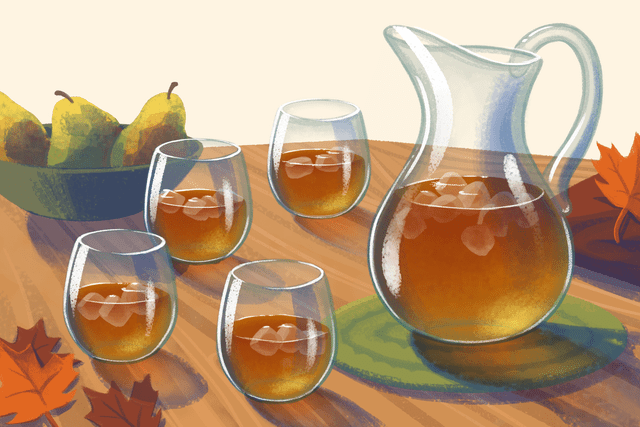Your Complete Guide to a Diabetes-Friendly Thanksgiving

Verywell / Mira Norian
Fact checked by Nick Blackmer
Thanksgiving is almost here and this food-centric holiday can be a challenge if you have diabetes. There’s more to think about than just the sugary desserts: the hearty side dishes, large portions, free-flowing alcohol, and family expectations.
Elizabeth Stasny, a university professor who has type 1 diabetes, has to be extra mindful of her blood sugar levels during the Thanksgiving holiday. Whether she’s hosting or attending a gathering, the holiday can make it difficult to stick to her diet and exercise routines.
“If you’re going somewhere else for dinner, either to a restaurant or somebody else’s house, then that’s another challenge because you don’t have control over what’s going in the food,” Stasny told Verywell.
But experts say Thanksgiving is a once-a-year celebration and you don’t have to avoid all your favorite foods. We spoke with dietitians for a Thanksgiving dinner guide tailored to people with diabetes. Instead of focusing on what to cut out, this guide offers swaps, tips, and tricks to make the holiday enjoyable and manageable.
Related: Type 1 vs. Type 2 Diabetes: What Are the Differences?
How to Swap for Diabetes-Friendly Ingredients
Whether you’re hosting or bringing one dish to a Friendsgiving celebration, there are ways to incorporate your dietary needs into the menu. Here are some potential diabetes-friendly swaps for classic Thanksgiving dishes.
Side Dish

Verywell / Mira Norian
Grace Derocha, RDN, MBA, CDCES, a dietitian and certified diabetes care and education specialist, said Thanksgiving dinner gets tricky because traditional dishes like mashed potatoes, mac and cheese, and dinner rolls are high in carbs.
But you can incorporate more vegetables into the meal. You can roast green beans or Brussels sprouts for a fiber-rich side, or work vegetables into a classic dish like mashed potatoes.
You can add cauliflower and white beans into mashed potatoes, which increases the protein and fiber content of the dish.
“If you’re a person with diabetes and you’re counting your carbs, you get a little bit more volume of it with less carbs that you would have to count,” Derocha said.
For an even more indulging side dish like sweet potato casserole, there are ways to reduce the sugar content, according to Mesa.
If your recipe includes added sugar, you can cut the amount in half and supplement it with warm spices like nutmeg and cinnamon, she said. You can also leave the added sugars out entirely, especially if you plan to top the dish with marshmallows.
Related: An Overview of Carb Counting
Main Course

Verywell / Mira Norian
Whether your main course is turkey, pork, fish, tofurkey, or ham, it’s typically going to be a source of protein. It can fill you up without increasing your blood sugar level too drastically.
Balancing the plate with protein, carbohydrates, and healthy fats is especially important for people with type 2 diabetes. A traditional American Thanksgiving plate with turkey, stuffing, and cranberry sauce can be a good combination for blood sugar management.
But for people with type 1 diabetes, it’s important to know what’s in all of the main course add-ons to dose insulin correctly, according to Stasny. Dressing, for example, is a potential problem because it might contain sugary ingredients like raisins and apples.
To manage this, Stasny said she would only eat small amounts of the dressing but she always carries glucose tablets or juice with her in case she is ever in a situation where she needs to bring up her blood sugar levels quickly.
Related: The Best Time to Check Blood Sugar
Dessert

Verywell / Mira Norian
People with diabetes don’t have to skip dessert. But Arévalo recommends making a treat that offers more than just carbs. You could do a bowl of fruit with a chocolate drizzle, or a coconut flan.
Flan is made with milk and eggs—two protein sources that counteract the carbs slightly, Arévalo said.
Related: Go-To Diabetes-Friendly Desserts
Beverage

Verywell / Mira Norian
When alcohol is combined with diabetes medications, there's a risk for hypoglycemia (low blood sugar). Drinking a glass of wine or cocktail during Thanksgiving dinner is mostly fine, but Arévalo said a festive mocktail can work as a good alcohol alternative. Here are three fall-themed mocktail recipes from Verywell.
Arévalo also shared her go-to cranberry lime margarita punch that tastes like a real margarita. The recipe is straightforward: just combine diet ginger ale, a few dashes of cranberry juice, and a squeeze of lime juice in a large punch bowl filled with ice.
Related: The Relationship Between Alcohol and Diabetes
How to Mentally Prepare Yourself for the Holiday
Before you think about the menu, experts say it’s important to create your boundaries and stress management “toolbox.” Stress hormones are known to cause blood sugar fluctuations, making it difficult to follow your diabetes management plan.
“Life is stressful, the holidays in general can be stressful, and that can impact our blood sugar numbers,” Amy Kimberlain, RDN, CDCES, a Miami-based registered dietitian who specializes in diabetes care, told Verywell.
Stress doesn’t only affect blood sugar levels, Kimberlain added, but it also affects food choices. To manage your stress, she recommended practicing breathing techniques, meditation, journaling, or even playing a favorite song that makes you get up and dance.
Related: Can Stress Cause High Blood Sugar?
When you’re ready to plan for the holiday, think about how many celebrations you’ll attend and who will be at each one.
Diana Mesa, RD, LDN, CDCES, a registered dietitian who founded En La Mesa Nutrition, said one of the biggest challenges for people with diabetes is “feeling pressured to eat certain things” that may not serve their needs.
You might worry about offending your loved ones, but it’s important to stick to your boundaries, Mesa said. You can always bring some reusable containers and offer to take leftovers home to enjoy later.

Verywell / Mira Norian
7 Tips on Strategizing for the Big Meal
If you’re attending Thanksgiving dinner instead of hosting, you may have less control over what’s offered on the menu. Here are eight dietitian tips to help you navigate the stuffed dining table.
Look at everything on the table
“Do a quick assessment of what’s being served, what is exciting you, and things that you don’t want to try,” Mesa said. It’s fine if you want to try a little bit of everything, but knowing what’s being offered can help you balance your plate.
Include carbs, protein, fat, and fiber on your plate
Since Thanksgiving tends to be a big meal, Kimberlain recommended thinking about traditional foods you don’t want to miss out on. Whether that’s pumpkin pie or sweet potato casserole, consider where carbs would be coming from so you can balance out the rest of your plate.
“Ideally, we’re doing half of a plate from non-starchy vegetables, a quarter of a plate from the protein, and a quarter of the plate from carbohydrates,” Kimberlain said.
Having carbs, protein, and fat on your plate helps manage blood sugar by preventing blood sugar from rising too quickly.
Related: Simple Carbohydrates vs. Complex Carbohydrates
Bring your own go-to dish
Offer to bring a dish to the celebration that you know you can eat, Kimberlain said. This can help ease the stress of not knowing what is being served and may help you balance out the rest of your plate.
Stay hydrated
If you plan to have alcoholic beverages at dinner, drink plenty of water throughout the day to stay hydrated. If you aren’t eating a lot, drinking alcohol can lead to an initial drop in blood sugar and then a spike when the alcohol is metabolized, according to Sandra Arévalo, MPH, RDN, CDN, director of community health and wellness at Montefiore Nyack Hospital.
“Your liver starts taking care of the alcohol and doesn’t do what it needs to do to manage your blood sugar,” Arévalo said.
And remember to factor in the extra calories and carbohydrates from mixed drinks.
Check your insulin numbers
For people with type 1 diabetes, knowing when to inject insulin is important. Keep in mind that the meal could be running late. “If there’s a delay, you don’t want them injecting too early,” Kimberlain said.
She added that your numbers might be slightly higher on Thanksgiving because you’re off your routine. Check in with your numbers, whether that’s on a pump or a sensor, and correct with a small micro-dose of insulin to get back in range.
Celebrate the day
Thanksgiving is a celebration of friends, family, and community. No matter what is being served and who sits around your table, people with diabetes can still enjoy the full experience.
“Tap into what your culture is and what traditions you might have that highlight that melting pot of what Thanksgiving is and be grateful for everything that you have,” Derocha said.
Related: Thanksgiving Tips for People With Diabetes
What About Exercising?
Any exercise during the day will help regulate blood sugar, according to Derocha. But it’s best to go for a family walk or help with cleaning up after the meal instead of sitting down on the couch right away. If watching a sports game together is part of your Thanksgiving tradition, you could add movement to the viewing party. “If your team scores then do that many jumping jacks or push-ups. And challenge the family to it,” Derocha said.
How to Be a Helpful Thanksgiving Host
If you know that a person with diabetes is coming to your Thanksgiving gathering, you can be a helpful host by letting them know what you’re serving.
Stasny, who might have to be more mindful of her Thanksgiving meals, said it’s especially helpful for her if she can know what the ingredients were.
For example, if someone with type 1 diabetes saw Derocha’s mashed potato dish and didn’t realize it had cauliflower and white beans, they may give themselves too much insulin to account for the carbs they thought were in the dish.
Arévalo also said children with diabetes may feel embarrassed by having different dishes made especially for them. She makes rainbow mac and cheese with mixed vegetables for added protein and fiber but makes sure it is offered to everyone.
“But I’m sharing with everybody else to normalize the situation,” she said.
Thanksgiving Isn’t About Perfection
Thanksgiving can be manageable for people with diabetes. Strategize in advance and limit stress where you can.
When it’s time to build your plate, aim for a balance of protein, healthy fats, and fiber along with carbs. Stay hydrated, add in exercise, and focus on enjoying the day.
“It’s okay to try a little bit of everything if you want to try a little bit of everything,” Mesa said. “Again, we’re not aiming for perfection, we’re not trying to stress out over the holidays or feel like we’re restricting over the holidays when we should really be participating and enjoying the festivities.”
Read the original article on Verywell Health.

